Dress
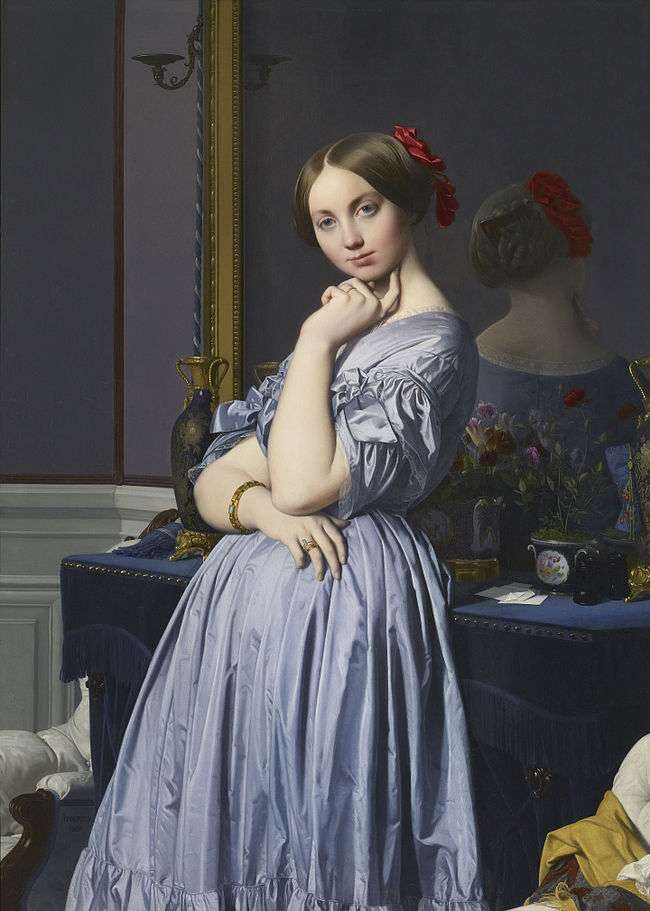
A dress (also known as a frock or a gown) is a garment consisting of a skirt with an attached bodice (or a matching bodice giving the effect of a one-piece garment).[1] In many cultures, dresses are more often worn by women and girls.
The hemlines of dresses vary depending on the whims of fashion and the modesty or personal taste of the wearer.[2]
History
Before the Victorian period, the word "dress" usually referred to a general overall mode of attire for either men or women, as reflected today in such phrases "evening dress", "morning dress", "travelling dress", "full dress", and so on, rather than to any specific garment. At that time, the most-often used English word for a woman's skirted garment was gown. By the early 20th century, both "gown" and "frock" were essentially synonymous with "dress", although gown was more often used for a formal, heavy or full-length garment, and frock or dress for a lightweight, shorter, or informal one. Only in the last few decades has "gown" lost its general meaning of a woman's garment in the United States in favor of "dress".
In the ancient world, for example Ancient Greece and Rome, both men and women wore a similar dress-like garment termed generically a tunic. From this developed the dress worn by women and male clothing such as cassocks and Fustanella worn by priests and soldiers respectively. An ancient Greek tunic, appearing on the Charioteer of Delphi inspired an early twentieth gown designer, Mariano Fortuny to create the Delphos gown in 1907.
19th century
Dresses increased dramatically to the hoopskirt and crinoline-supported styles of the 1860s, then fullness was draped and drawn to the back. Dresses had a "day" bodice with a high neckline and long sleeves, and an "evening" bodice with a low neckline (decollete) and very short sleeves.
Throughout this period, the length of fashionable dresses varied only slightly, between ankle-length and floor-sweeping.[2]
20th and 21st centuries

Beginning around 1915, hemlines for daytime dresses left the floor for good. For the next fifty years fashionable dresses became short (1920s), then long (1930s), then shorter (the War Years with their restrictions on fabric), then long (the "New Look").
Since the 1970s, no one dress type or length has dominated fashion for long, with short and ankle-length styles often appearing side-by-side in fashion magazines and catalogs.[3]
Usage
In most varieties of formal dress codes in Western cultures, a dress of an appropriate style is mandatory for women. They are also very popular for special occasions such as proms or weddings.[4] For such occasions they, together with blouse and skirt, remain the de facto standard attire for many girls and women.
Lengths
_2.jpg) Long dress - a floor-length gown typically worn for evening or formal occasions.
Long dress - a floor-length gown typically worn for evening or formal occasions. Maxi dresses (c.1970) - maxi is a term used since the late 1960s[5] for ankle-length, typically informal dresses.
Maxi dresses (c.1970) - maxi is a term used since the late 1960s[5] for ankle-length, typically informal dresses. Midi dress - a mid-calf length dress.
Midi dress - a mid-calf length dress.- Knee length dress.
.jpg) Mini dress (1960s) - worn historically but introduced as high fashion by Mary Quant and others, mini-length hemlines hit between the knee and upper thigh.
Mini dress (1960s) - worn historically but introduced as high fashion by Mary Quant and others, mini-length hemlines hit between the knee and upper thigh. Micro dress (right) with minidresses, 2008.
Micro dress (right) with minidresses, 2008.
Types
Defined by cut/construction
- Bouffant gown, an elaborate gown with a puffed or 'bouffant' skirt.
 Bustle dress, a dress with exaggerated back fullness or detailing. (1870s onwards)
Bustle dress, a dress with exaggerated back fullness or detailing. (1870s onwards) Crinoline dress, a dress with an exaggeratedly full skirt supported by hoops or multiple petticoats. (1850s onwards)
Crinoline dress, a dress with an exaggeratedly full skirt supported by hoops or multiple petticoats. (1850s onwards) Frock, a "girlish" style of dress. Frock is also a term for a type of man's coat.
Frock, a "girlish" style of dress. Frock is also a term for a type of man's coat.
 Jumper dress, a sleeveless dress worn over a blouse.
Jumper dress, a sleeveless dress worn over a blouse.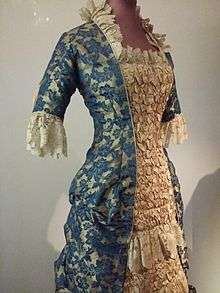 Princess dress, a fitted dress shaped by long shaped panels and seams rather than by darts.
Princess dress, a fitted dress shaped by long shaped panels and seams rather than by darts. Sailor dress, a dress with sailor collar and styling. Also known as a Peter Thomson dress.
Sailor dress, a dress with sailor collar and styling. Also known as a Peter Thomson dress. Sheath dress, a form fitting (or sheath-like) dress.
Sheath dress, a form fitting (or sheath-like) dress. Shift dress or chemise, a short, sleeveless dress in a simple style with little detailing.
Shift dress or chemise, a short, sleeveless dress in a simple style with little detailing.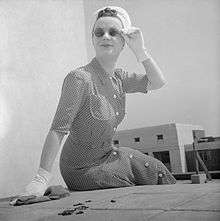 Shirtdress, a dress borrowing details from the style of a men's shirt, often including collar or front buttons.
Shirtdress, a dress borrowing details from the style of a men's shirt, often including collar or front buttons..jpg) Slip dress, a dress closely resembling a petticoat.
Slip dress, a dress closely resembling a petticoat. Strapless dress, a dress with no visible means of support (usually held up by interior corsetry or boning, or by elasticated fabric.)
Strapless dress, a dress with no visible means of support (usually held up by interior corsetry or boning, or by elasticated fabric.) Trapeze dress, an exaggerated A-line dress flaring from a fitted shoulder.
Trapeze dress, an exaggerated A-line dress flaring from a fitted shoulder. Wrap dress, a dress having a front closure which wraps around the body, forming a v-shaped neckline.
Wrap dress, a dress having a front closure which wraps around the body, forming a v-shaped neckline.
Defined by purpose/function
 Ball gown, a very formal dress, typically elaborate and floor-length.
Ball gown, a very formal dress, typically elaborate and floor-length. Cocktail dress, a semi-formal dress suitable for cocktail parties or similar events.
Cocktail dress, a semi-formal dress suitable for cocktail parties or similar events.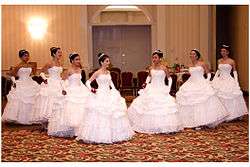 Débutante dress, a white dress worn by young women at debutante cotillions.
Débutante dress, a white dress worn by young women at debutante cotillions. Evening gown, a dress worn for evening or formal occasions.
Evening gown, a dress worn for evening or formal occasions. House dress, an informal dress worn for housework.
House dress, an informal dress worn for housework.- Little black dress, an evening or cocktail dress, often short, a popular wardrobe staple since the 1920s.
 Nightdress, worn as sleepwear, available in a variety of styles.
Nightdress, worn as sleepwear, available in a variety of styles..jpg) Sundress, a lightweight, usually sleeveless dress intended for wearing in warmer weather.
Sundress, a lightweight, usually sleeveless dress intended for wearing in warmer weather. Tea gown, a late 19th/early 20th-century gown intended for wearing at home for tea and other informal social occasions.
Tea gown, a late 19th/early 20th-century gown intended for wearing at home for tea and other informal social occasions. There are numerous styles of wedding dress worn exclusively by the bride at her wedding. In Western cultures, white is the most popular colour.
There are numerous styles of wedding dress worn exclusively by the bride at her wedding. In Western cultures, white is the most popular colour.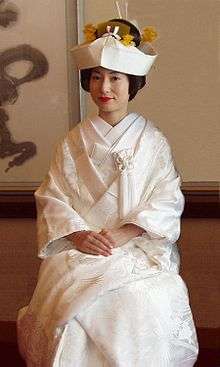 Traditional Japanese kimono-style wedding dress.
Traditional Japanese kimono-style wedding dress. Traditional Bahrain wedding dress.
Traditional Bahrain wedding dress.
In world culture
 Abaya, a loose over-dress or caftan particularly associated with the Arabian peninsula.
Abaya, a loose over-dress or caftan particularly associated with the Arabian peninsula.- Áo dài, a traditional Vietnamese dress often worn over long pants.
 Cheongsam (or qipao), a one-piece Chinese dress.
Cheongsam (or qipao), a one-piece Chinese dress. Kameez/qameez/qamis, a generic term for tunics and gowns typically worn over pants (shalwar) in Muslim and South Asian cultures.
Kameez/qameez/qamis, a generic term for tunics and gowns typically worn over pants (shalwar) in Muslim and South Asian cultures. Kimono, the traditional layered dress of Japan.
Kimono, the traditional layered dress of Japan. Sari, a style of clothing worn by women in the Indian Subcontinent.
Sari, a style of clothing worn by women in the Indian Subcontinent.
See also
- 1795–1820 in fashion
- 1820s in fashion
- 1830s in fashion
- 1840s in fashion
- 1850s in fashion
- 1860s in fashion
- 1870s in fashion
- 1880s in fashion
- 1890s in fashion
- Artistic Dress movement
- Bustle
- Clothing terminology
- History of Western fashion
- Sarong
- Women wearing pants
- Victorian dress reform
- Victorian fashion
References
- ↑ Condra, Jill. The Greenwood Encyclopedia of Clothing Through World History: 1801 to the present. Greenwood Publishing Group. p. 59. ISBN 9780313336652.
- 1 2 Davis, Michael (2007). Art of dress designing (1st ed.). Delhi: Global Media. ISBN 81-904575-7-8.
- ↑ changing hemlines
- ↑ Pundir, Nirupama (2007). Fashion technology : today and tomorrow. New Delhi: Mittal Publications. ISBN 81-8324-203-0.
- ↑ Cumming, Valerie; Cunnington, C.W.; Cunnington, P.E. (2010). The dictionary of fashion history (Rev., updated and supplemented [ed.]. ed.). Oxford: Berg. p. 130. ISBN 9780857851437.
- Brockmamn, Helen L.: The Theory of Fashion Design, Wiley, 1965.
- Picken, Mary Brooks: The Fashion Dictionary, Funk and Wagnalls, 1957. (1973 edition ISBN 0-308-10052-2)
- Tozer, Jane, and Sarah Levitt: Fabric of Society: A Century of People and Their Clothes 1770–1870, Laura Ashley Ltd., 1983; ISBN 0-9508913-0-4
External links
| Wikimedia Commons has media related to Dresses. |
| Wikimedia Commons has media related to Minidresses. |